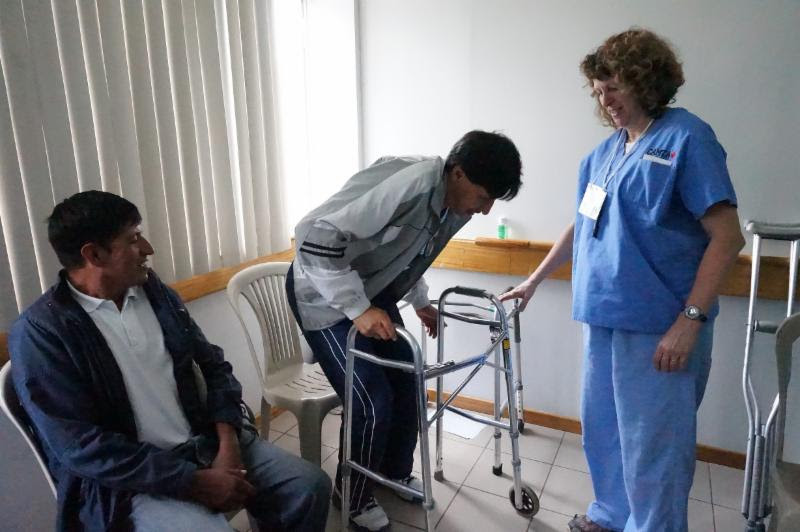Week Two – Sunday's Blog
The first half of the Week 2 team arrives in a bus at the Un Canto a la Vida Hospital at 8:30AM. The team unloads hockey bags containing medical equipment and supplies required for the week. As we enter the hospital, we are greeted by applause and “buenos dias” by dozens of new and former patients and their families. It's the perfect start for the week, as the appreciation and gratitude from the families further energizes the team! It also signifies the magnitude of the impact that CAMTA has had over the last 14 years in improving quality of life for those receiving treatments, and also their families.

Patients and families greet the CAMTA week 2 team

The team with hockey bags full of essential supplies for the week
The CAMTA team spends the next two hours moving and unpacking the hockey bags and setting up tables and chairs in the clinic area for patient registration. We arrange rooms for the general practitioners, adult and pediatric surgeons, anesthetists, orthopedic and anesthetic residents, medical students and nurses to assess the patients. A physiotherapy pre-op training area is also established. By10:30 AM, the clinic is setup and ready for processing patients, and the second bus of CAMTA volunteers arrives at the hospital, again greeted with applause and cheers. With the entire team assembled, the day starts with a quick reminder of the workflow process from Dr. Saifee Rashiq to ensure the Clinic day operations run smoothly.


Dr. Saifee Rashiq gathers the team to explain the patient flow through the clinic
The first step of the process for all patients, whether adult or pediatric, is to complete registration. This is led by Greg Zinter and Dan Lefebvre with the assistance of a translator. Each patient is assigned a unique CAMTA identification number, and patient information along with their photograph is stored in a computer database. CAMTA sees many returning patients for follow ups, and their profiles can be quickly accessed from this database as needed.

Greg Zinter and Toby Cubitt (translator) complete patient registration on Clinic Day. Orthopedic Resi
One of the first patients of the day is Carla, a 2-year old girl with left hip dislocation. Carla is a returning patient, and underwent surgery for her right hip reduction last year. Pediatric ward nurses Dianne Cortez and Julie Cadrin are excited to see Carla and her family after a year.

Pediatric Ward nurses Dianne Cortez and Julie Cadrin with 2-year old Carla and her family. Carla will undergo left hip surgery this week.
After registration is complete, Carla makes her way to a consult with pediatric orthopedic surgeon, Dr. Sumit Gupta. Translator Alexandria (Alex) Tapia assists with communication in Spanish with Carla's family. Carla's x-rays show excellent recovery on her right hip on which she received surgery last year. This year, Carla will undergo a similar surgery for her left hip.


Pediatric Orthopedic Surgeons Dr. Sumit Gupta & Dr. Marc Moreau examine Carla's x-rays, and translator Alex Tapia assists in communication.
After the consultation is complete, a pediatric ward nurse works with Carla and her mother to review and document information about her family medical history, vaccinations, and exposures to disease and infections. Carla's blood pressure and temperature are checked and recorded in her chart to determine that she is healthy for surgery.







The week 2 clinic day has been very successful with 11 pediatric and 20 adult surgeries on the schedule for the week. As word spreads about CAMTA and new cases come up, it's quite common for more people to show up for consult throughout the week, bringing some changes to the preliminary surgery schedule. The schedule is adapted to accommodate the changing dynamics. At the end of the day, 2 pediatric surgeries, and 4 adult surgeries are scheduled for Monday.


CAMTA team members Dan Lefebvre, Aline Young, Sandra Muchekeza and Greg Zinter help collect paperwork and supplies during the cleanup. Supplies are loaded on a stretcher to transport to another floor.
